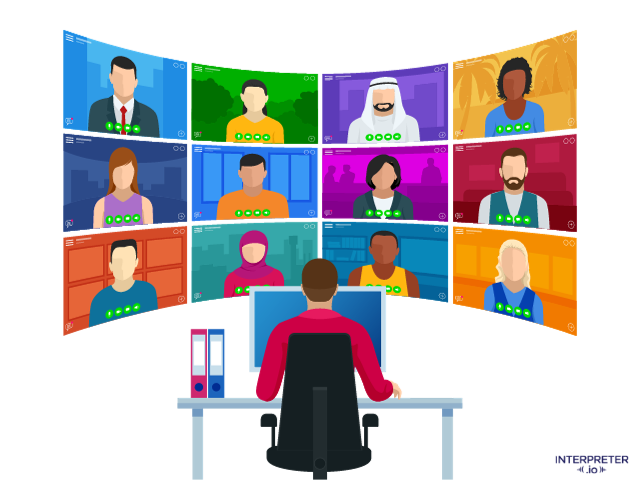VRS Versus VRI: Revolutionizing Interpretation Services in a Connected World
 Interpreting services have become important in our globalized society, bridging language barriers across various sectors. Among these services, Video Relay Service (VRS) and Video Remote Interpreting (VRI) have emerged as vital tools.
Interpreting services have become important in our globalized society, bridging language barriers across various sectors. Among these services, Video Relay Service (VRS) and Video Remote Interpreting (VRI) have emerged as vital tools.
But what are they, and how do they differ? These interpreting methods are not just technological advancements but are essential for effective communication in diverse fields such as healthcare, legal, and business.
While they share a common goal of facilitating understanding, each has unique features and applications. This article aims to clarify these differences and highlight their significance in various professional contexts.
Understanding Interpreting Services
 Interpreting services play a crucial role in making communication accessible to people who speak different languages. This is especially true in settings like hospitals, courts, or international conferences, where clear understanding is important.
Interpreting services play a crucial role in making communication accessible to people who speak different languages. This is especially true in settings like hospitals, courts, or international conferences, where clear understanding is important.
Two popular types of these services are Video Relay Service (VRS) and Video Remote Interpreting (VRI).
Video Relay Service (VRS)
Video Relay Service primarily serves the deaf and hard-of-hearing community. In VRS, the interpreter uses sign language to communicate the spoken content. This method is particularly useful in settings where the participants are in different locations, and at least one individual relies on sign language for communication.
Video Remote Interpreting (VRI)
Video Remote Interpreting caters to a broader range of interpreting needs. VRI can be used for spoken languages as well as sign language, facilitating communication between people who do not share a common language. This flexibility makes VRI an invaluable tool in various settings, from business meetings to medical consultations, where having an interpreter physically present is challenging.
Comparing Video Relay Service and Video Remote Interpreting
Target Users
VRS is specifically designed for the deaf and hard-of-hearing community. It's a critical tool that enables these individuals to engage in conversations with the same ease as hearing people, using sign language as the medium.
The Federal Communications Commission outlines how VRS allows persons with hearing disabilities to communicate with voice telephone users through video equipment.
VRI has a broader target audience. It is not only used by the deaf and hard-of-hearing but also by people who speak different languages. This service bridges language barriers in various professional and personal scenarios, making communication accessible to a diverse population.
Communication Method
In VRS, the communication takes place via video telephones or similar devices. This setup allows for real-time conversations where the interpreter interprets what the hearing person says into sign language and vice versa.
While VRI utilizes advanced video conferencing technology. This setup is particularly effective in situations where face-to-face interactions are not possible or practical, like in remote business meetings, telemedicine appointments, or international conferences.
Context of Use
VRS is mainly used for everyday personal communication. It plays a vital role in social interactions, workplace communication, and accessing public services for the deaf and hard-of-hearing.
VRI, due to its flexibility, is used in a variety of contexts. These include healthcare, where it ensures accurate communication between patients and healthcare providers, in legal settings for depositions or client meetings, in educational institutions for lectures or parent-teacher meetings, and in corporate settings for international meetings.
Practicality and Accessibility
VRS is not just about facilitating communication; it's about empowering the deaf and hard-of-hearing community to participate fully in society. It offers them independence in their day-to-day interactions.
VRI provides a practical solution in circumstances where traditional interpreting services are not feasible. Its ability to be quickly set up and used anywhere with an internet connection makes it invaluable in urgent or unplanned situations.
How Video Relay Service and Video Remote Interpreting Works
 Video Relay Service (VRS) and Video Remote Interpreting (VRI) are two distinct modes of interpreting services that use video technology, but they serve different purposes and operate in unique ways. Here's a breakdown of how each works and how they facilitate communication:
Video Relay Service (VRS) and Video Remote Interpreting (VRI) are two distinct modes of interpreting services that use video technology, but they serve different purposes and operate in unique ways. Here's a breakdown of how each works and how they facilitate communication:
Video Relay Service (VRS)
How it Works:
User Connection: A deaf or hard-of-hearing individual uses a videophone, smartphone, or computer with a camera to connect to a VRS provider.
Interpreter Connection: The VRS provider connects the individual to a sign language interpreter via video.
Communication with Hearing Person: The interpreter then places a phone call to the hearing person with whom the deaf individual wants to communicate. This is done through standard voice telephone.
Communication Process:
From Sign to Voice: The deaf individual signs to the interpreter through the video link. The interpreter, who is fluent in sign language and the spoken language, voices the signed message to the hearing person on the other end of the phone call.
From Voice to Sign: When the hearing person responds, the interpreter signs the spoken words back to the deaf individual.
Real-Time Interaction: This process allows for real-time conversation between the deaf and hearing individuals, with the interpreter facilitating the communication seamlessly.
Video Remote Interpreting (VRI)
How it Works:
Remote Setup: VRI involves an interpreter who is located remotely, providing interpreting services via video conferencing technology.
Two-Party or Multi-Party Connection: Both parties (or more, in group settings) needing interpretation services connect via a video link, often using devices like tablets, laptops, or dedicated video conferencing systems.
Communication Process:
Interpreting the Conversation: The interpreter listens to the spoken language and interprets it into sign language or another target language for the benefit of the person who needs interpretation.
Versatile Language Support: Unlike VRS, which primarily focuses on sign language, VRI can be used for interpreting a wide range of spoken languages.
Applicability: VRI is used in various settings, including medical appointments, business meetings, conferences, educational classes, and legal consultations.
Industry Applications of VRS and VRI
 Healthcare
Healthcare
In healthcare, VRS and VRI are invaluable for ensuring clear communication. VRS is particularly useful for deaf or hard-of-hearing patients, facilitating communication through sign language interpreters via video.
This setup is crucial during medical consultations or emergencies, ensuring accurate information exchange for effective diagnosis and treatment.
VRI, on the other hand, assists in situations where spoken language interpretation is required, like in communicating with patients who speak different languages.
Business
In the business world, VRS and VRI facilitate global communication. Companies use these services for international meetings, training sessions, and conferences.
They help overcome language barriers in real-time, enabling smoother negotiations and collaborations. For example, a multinational corporation might use VRI to include a Japanese-speaking executive in a meeting held in English.
Legal
The legal sector greatly benefits from both VRS and VRI. They are used in courtrooms, law offices, and during legal proceedings where precise communication is essential.
VRS allows deaf or hard-of-hearing individuals to participate fully in legal proceedings, ensuring their right to accessible communication. Similarly, VRI is used for spoken language interpretation, ensuring that non-native speakers or those who communicate in different languages can understand and be understood in legal settings.
Advantages and Disadvantages
Video Relay Service
Advantages
Improved Communication for the Deaf and Hard-of-Hearing:
VRS enables effective communication for the deaf and hard-of-hearing community by providing real-time sign language interpretation. This bridges the gap for individuals who rely on sign language as their primary means of communication.
Real-Time Interaction:
Unlike other forms of communication aids, VRS offers real-time interaction, which is crucial for dynamic conversations, such as in interviews, meetings, or medical consultations.
No Need for Physical Presence:
The service reduces the need for a sign language interpreter to be physically present, making it easier to arrange and often more cost-effective.
Disadvantages
Dependence on Technology:
VRS requires a stable internet connection and suitable devices. Any technical issues, like poor connectivity or equipment failure, can disrupt the service.
Limited to Sign Language Users:
VRS is specifically designed for sign language users. Those who are deaf or hard-of-hearing but do not use sign language may not find this service as beneficial.
Privacy Concerns:
In VRS, a third party is involved in what might be private or sensitive conversations. While interpreters are professionals bound by confidentiality, some users may still have concerns about privacy.
Video Remote Interpreting
Advantages
Flexibility and Convenience:
VRI provides the flexibility to access interpreting services from any location. This is especially useful in situations where in-person interpreters are not available or when immediate interpreting is needed.
Cost-Effectiveness:
By eliminating the need for interpreters to travel, VRI reduces costs related to transportation and time. This makes it a more affordable option for many businesses and individuals.
Broad Range of Applications:
VRI is versatile and can be used in various settings, including healthcare, legal, education, and business meetings, enhancing communication across different fields.
Disadvantages
Technology Dependence:
VRI relies heavily on technology. Issues like poor internet connection, software problems, or inadequate equipment can disrupt the interpreting process.
Limited Personal Interaction:
While VRI provides visual contact, it lacks the physical presence of an interpreter, which can be crucial in certain situations, such as when sensitive or complex information is being discussed.
Quality Concerns:
The quality of VRI can vary depending on the service provider. Factors like the interpreter’s skills, video quality, and audio clarity play a significant role in the effectiveness of the service.
Choosing Between VRS and VRI
Selecting between Video Relay Services (VRS) and Video Remote Interpreting (VRI) largely depends on your specific needs. VRS is primarily used by deaf or hard-of-hearing individuals to communicate with hearing people through a sign language interpreter.
This service is commonly used for personal calls where the deaf user initiates the call. VRI, on the other hand, is used in various professional settings like meetings, medical appointments, or conferences, where an interpreter relays information between parties who speak different languages, including sign language.
When considering VRS, think about the communication flow and the level of personal interaction required. It’s ideal for quick, direct communication.
For VRI, assess the setting's formality and the need for specialized language skills, such as medical or legal terminology. It's more about the content and context of the interaction rather than the mode of communication.
Also, factor in the availability of interpreters and the technological setup. While both services rely on video technology, VRI might require more advanced equipment for clear communication in professional settings.
Conclusion
Video Remote Interpreting (VRI) and Video Relay Service (VRS) each play a pivotal role in breaking down communication barriers. They offer immediate, cost-effective, and high-quality interpreting solutions, crucial for providing access to essential services.
Both VRI and VRS have their unique strengths and limitations, and the key to effective communication lies in finding the right balance between the two.
As technological advancements progress, video remote interpreting is becoming more and more suited for overcoming geographical barriers. This development is streamlining communication across distances.
As we move forward, the integration and evolution of these services will continue to shape the landscape of interpreting and facilitate inclusive communication across various sectors.
If you’re looking for a platform where you can book video remote interpreting and find out how our innovative software can transform your interpreter scheduling needs, you can visit Interpreter IO for more details.
